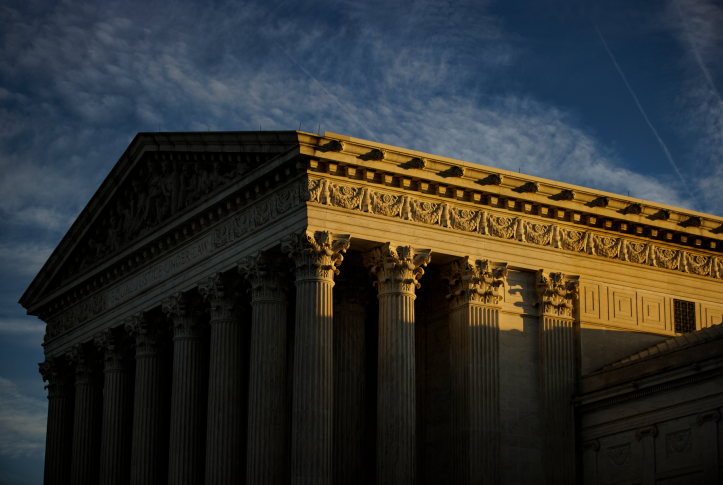On November 8, the Supreme Court heard oral arguments in a case that could end federal court protection for millions who receive benefits from federal spending programs administered by the states, including Medicaid and the Supplemental Nutrition Assistance Program.
The lawsuit, Health and Hospital Corporation of Marion County v. Talevski, was brought by a resident in a county nursing home in Indiana who was subject to overmedication and an involuntary transfer, which his estate claims violated his rights as found in the Medicaid statute. The lawsuit was brought under Section 1983 of title 42 of the United States Code, a provision of the Civil Rights Act of 1871, which states that any person deprived “of any rights, privileges, or immunities secured by the Constitution and laws” of the United States by a state official can sue in federal court to protect those legal rights.
Although the Talevski case itself concerns the rights of nursing home residents, other basic rights — like a prompt determination of a Medicaid application or coverage of children’s health services — are at stake. Based on the justices’ questions, it seems the protections will survive, although some justices seemed open to reconsidering when rights would receive protection.
The Arguments
The Court heard arguments from four advocates. Lawrence Robbins argued for the nursing home that programs adopted by Congress under its power to spend money operate as contracts between the states and the federal government. In these contracts, the federal government provides funds, and the states agree to abide by certain program requirements. Program beneficiaries are not parties to those contracts, and under contract law as it existed in the 1870s (when section 1983 was passed) could not sue as “third-party beneficiaries.” He also claimed that nursing home residents’ rights were specifically not enforceable because the Nursing Home Reform Act provides other remedies and imposed general obligations on the nursing home rather than creating specific rights for residents. Thomas Fisher, arguing for the state of Indiana, further argued that the current law on enforceable rights for programs like Medicaid is confusing, seriously frustrates and disrupts state programs, and forces states to assume liability they have not agreed to.
Benjamin Snyder, representing the United States, argued in support of beneficiaries’ right to sue in general, but backed the nursing home on the issue of 1983 suits by residents. He argued that the Court has for decades held that 1983 suits can be brought to protect program beneficiaries and that Congress had ratified this authority. On the other hand, he argued that nursing home residents’ statutory rights specifically could not be protected under 1983 because they are protected by other remedies. Further, because most nursing homes are not run by states and 1983 only applies to state officials, Congress could not have intended 1983 as a way to sue state-run homes.
Finally, Andrew Tutt, arguing for the Talevski estate, agreed with the federal government that section 1983 allows beneficiaries of spending clause programs to sue states to enforce program requirements, and contended further that nursing home residents’ rights specifically are enforceable under 1983.
Justices Seem Likely to Allow Federal Lawsuits to Protect Medicaid Rights
Although several justices have used the contract analogy when describing federal spending programs, only Justices Thomas and Alito seemed to fully buy the argument put forth by Robbins and Fisher that this excluded program beneficiaries from suing under 1983.
Several justices explicitly rejected this position. Justice Sotomayor questioned the accuracy of the claim that contract law at the time 1983 was adopted did not allow beneficiaries to sue. Justice Jackson noted that 1983 creates an express right to sue to enforce federal laws and does not exclude laws governing spending programs like Medicaid. She accused the petitioners of inviting the court to rewrite 1983. Justice Barrett asserted that the contract argument was not “connecting the dots” with 1983 (i.e., did not seem relevant). At most, there seem to be only two, or possibly three, votes for denying all litigation rights.
Nursing Home Resident Rights Are Less Certain
Most of the justices’ questions focused on the second issue: whether nursing home residents’ rights are enforceable under 1983. This is partly a question about whether these rights are sufficiently clear to be protected under 1983. Chief Justice Roberts, Justice Kagan, and Justice Kavanaugh pushed back on Robbins’ assertion that the rights of residents were not clear in the statute. “The statute says rights, over and over again,” said Kavanaugh. Roberts and Barrett said that the requirement that rights under a federal law be “unambiguous” (according to an earlier case) before they are protected by 1983 is sufficient to put states on notice that they are potentially liable for violating such rights.
Much of the discussion focused on whether Congress meant to preclude 1983 suits by making rights to administrative hearings available under the Nursing Home Reform Act. Does the availability of alternative remedies under a statute prohibit 1983 suits, or are 1983 suits permitted unless those remedies are in some way incompatible with or “in tension” with 1983, as Justice Kagan asserted? Are administrative remedies — such as hearings before an administrative judge — enough, or do alternative judicial remedies have to be available? What about the fact that the administrative remedies cannot provide financial compensation for injuries? Justice Sotomayor noted that judicial remedies are needed because federal and state governments lack resources to deal with all violations of federal program requirements through enforcement proceedings.
Justice Kavanaugh and Chief Justice Roberts seemed particularly focused on the question of whether administrative remedies are an adequate substitute for 1983. A decision that systematically required program beneficiaries to use state administrative appeals or rely on the federal government to pursue enforcement remedies in lieu of 1983 suits would seriously limit beneficiary rights.
The Supreme Court has another case it could hear this term that could restrict beneficiary rights under Medicaid, but for now the threat seems diminished, meaning that millions of Americans may retain their ability to use the federal courts to remedy a violation of federal rights.




